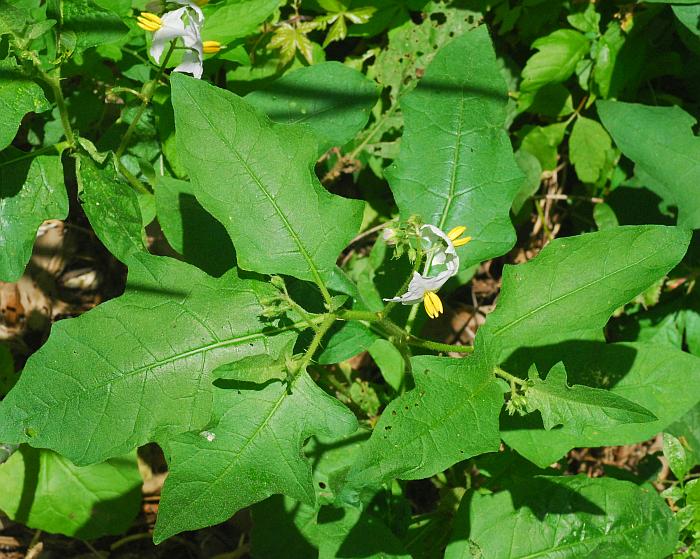Solanum carolinense L.
Horse Nettle

Native
CC = 0
CW = 3
MOC = 87
© SRTurner
Solanum carolinense L.Horse Nettle | |
 |
Native CC = 0 CW = 3 MOC = 87 |
© SRTurner |
|
Family - Solanaceae Habit - Perennial forb with relatively deep rhizomes. Stems - Ascending to erect, to 1.0 m, usually with several ascending branches, moderately to densely pubescent with minute, stellate, nonglandular hairs, also with moderate to dense, larger, stellate hairs having the central branch erect and elongate, the green tissue not obscured by hairs; armed with scattered to relatively common, flattened, straight, straw-colored to greenish yellow prickles 2-4 mm long.
Leaves - Alternate, petiolate, armed with scattered prickles, mostly along the petiole and main veins, the petiole often winged toward the tip, moderately to densely stellate-hairy, the hairs mostly with the central branch erect and elongate. Leaf blades 2-8 cm long, simple, ovate to elliptic-ovate or oblong-elliptic, rounded or more commonly angled or tapered to a bluntly or sharply pointed tip, variously tapered, angled, truncate, or occasionally rounded at the base, often somewhat oblique, the margins with 2-5 coarse teeth or shallow lobes per side or sometimes merely wavy, the surfaces moderately to densely pubescent with stellate hairs, these sessile, with 4-9 branches, the central branch vertically spreading, the green tissue not obscured by the hairs.
Inflorescences - Axillary near the stem tips, sometimes appearing terminal, simple (unbranched) racemes of 5-20 flowers, the flower stalks not jointed, slender to moderately stout, thickened toward the tip. Inflorescence axis with sparse to moderate, short prickles, pubescence similar to the stems, elongating as the fruits develop.
Flowers - Spreading to ascending, the stalks becoming nodding as the fruits develop. Calyces 5-7 mm long at flowering, becoming slightly enlarged to 8-9 mm at fruiting (but the tips of the lobes often breaking off), the tube loosely cupping the base of the fruit, deeply 5-lobed at flowering, the lobes much longer than the tube, lanceolate to narrowly lanceolate, the outer surface unarmed, moderately to densely stellate-hairy. Corollas 10-15 mm long, white or purplish-tinged, sometimes more uniformly pale purple to pale bluish purple, lobed to at or more commonly above the midpoint, the lobes broadly triangular, usually appearing entire along the margins, tapered abruptly to bluntly or sharply pointed tips, spreading to slightly reflexed at flowering, the inner surface glabrous, the outer surface stellate-hairy. Stamens 5, alternating with corolla lobes. Anthers 6-9 mm long, narrowly oblong, yellow, dehiscing by terminal pores. Ovary 2-locular, the surface sparsely to moderately stellate-hairy, the style greenish, glabrous, exserted from the anther ring.
Fruits - Globose berries 1-2 cm long, lacking stony granules, green mottled with darker green, becoming bright yellow at maturity, shiny, unarmed, glabrous or very sparsely stellate-hairy, often with a few, small, white flecks, usually becoming somewhat wrinkled with age, frequently persisting until the next growing season. Seeds 1.5-3.0 mm in longest dimension, broadly ovate to broadly oblong in outline, sometimes bluntly angular, moderately flattened, unwinged, the surface smooth or very slightly few-wrinkled, brown to dark brown or grayish brown, dull or somewhat shiny.
Flowering - May - October. Habitat - Streambanks, pond margins, sloughs, marshes, forest openings, upland prairies, glades, fields, pastures, railroads, roadsides, open disturbed areas. Origin - Native to the U.S. Lookalikes - S. dimidiatum (which is considerably rarer). Other info. - This spiny native is common across Missouri and the eastern half of the continental U.S. The majority of states in the U.S. Midwest classify it as a noxious weed. Many home gardeners would agree with this characterization, as the sharp spines on the stem easily penetrate the skin and then tend to break off. The plant is easily recognized by the spiny stems, lobed leaves, and distinctive flowers. The flowers are most commonly white but can range to light purple or blue, which contrasts nicely with the large yellow anthers. The fruits, which somewhat resemble small cherry tomatoes, tend to persist over the winter. They contain high concentrations of solanine alkaloids and are toxic enough to be dangerous if consumed. Photographs taken off Hwy 106, Shannon County, MO., 5-26-03, and in Springfield, MO., 7-5-03 (DETenaglia); also at Marais Temps Clair Conservation Area, St. Charles County, MO, 9-30-2006, Shaw Nature Reserve, Franklin County, MO, 6-3-2007 and 10-6-2014, Weldon Spring Conservation Area, St. Charles County, MO, 7-6-2009, Cuivre River State Park, Lincoln County, MO, 8-16-2010, Sappington Bridge access, Crawford County, MO, 8-24-2010, and along the Katy Trail near Dutzow, Warren County, MO, 7-4-2014 (SRTurner). |